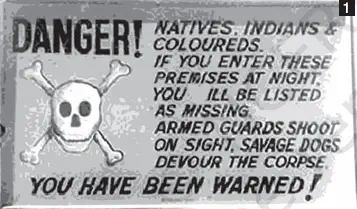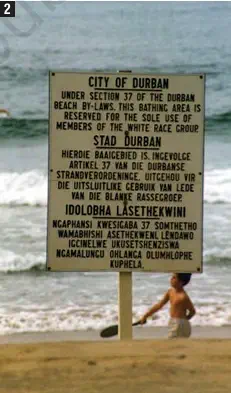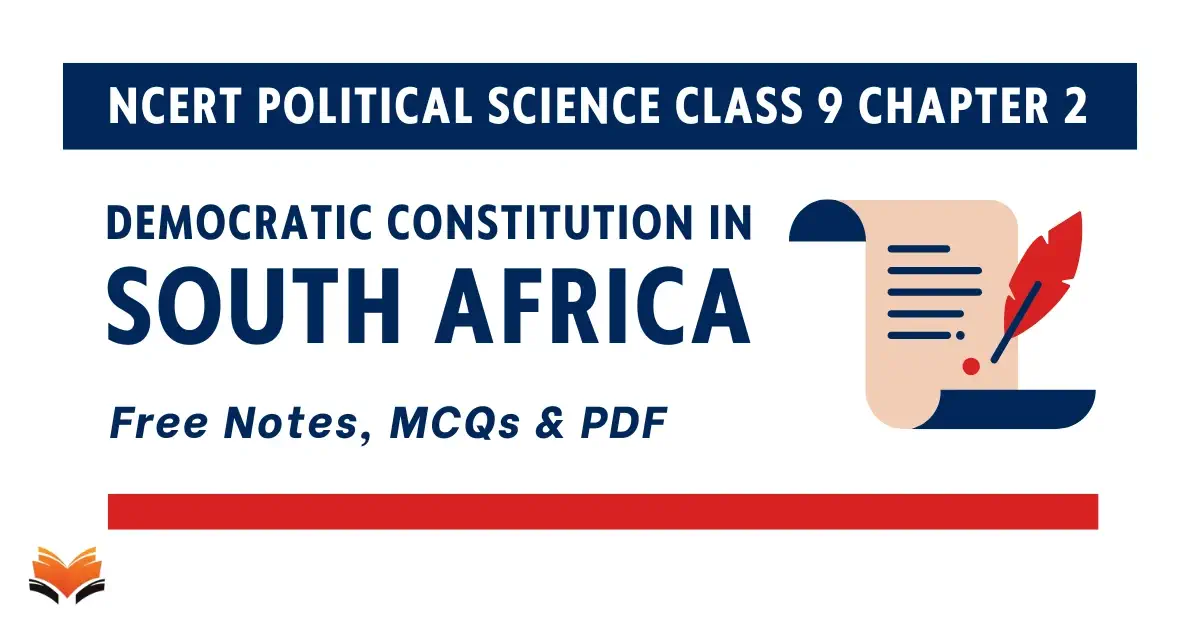Democratic Constitution In South Africa – Concept & Notes PDF
Topic covered: Democratic Constitution In South Africa class 9 notes and MCQs Questions: Constitutional Design (All single detail notes are exam-oriented).
We have discussed in-depth and exam-oriented pointers that can be asked in the board exam of class 9th about the “Democratic Constitution In South Africa“ from the NCERT Political Science (Civics) notes for class 9th chapter 2 Constitutional Design.
Download the NCERT Political Science (Civics) for Class 9th Chapter 2 Constitutional Design Notes PDF
Chapter 2: Constitutional Design in Class 9 Political Science explains how a constitution is created and why it is essential for a democracy. It uses the story of South Africa’s struggle against apartheid to show how rules and principles shape equality and justice. Students often get confused with terms like “assembly” or “sovereignty,” so these notes simplify them with clear explanations. Important ideas such as fundamental rights, guiding values, and the purpose of the Preamble are highlighted in an easy-to-follow manner. Download the NCERT Political Science (Civics) for Class 9th Chapter 2 Constitutional Design Notes PDF to revise effectively.
Overview
1. Basic Idea of Constitution:
- In a democracy, rulers are not free to do whatever they like.
- Both citizens and the government must follow certain basic rules.
- These rules together are called the Constitution.
- The Constitution is the supreme law of the country.
2. Functions of the Constitution:
- It determines the rights of citizens.
- It defines the powers of the government.
- It decides how the government should function.
3. Examples for Study:
- South Africa: Recent instance of designing a constitution for a democratic state.
- India: Study of how the Constitution was made, its foundational values, and how it provides a framework for citizens and government.
4. Key Questions About Constitutional Design:
Question 1. Why do we need a constitution?
Answer:
- A constitution sets the basic rules for how a country is governed.
- It protects the rights of citizens.
- It limits the powers of the government.
- It ensures that rulers cannot misuse their power.
Question 2. How are constitutions drawn up?
Answer:
- Constitutions are made after wide discussions and debates.
- They are often created when countries become independent or adopt democracy.
- They are written by representatives chosen by the people.
Question 3. Who designs them and in what way?
Answer:
- Constitutions are designed by a special assembly of representatives.
- These representatives reflect the wishes and interests of the people.
- They design it through discussion, compromise, and agreement.
Question 4. What values shape constitutions in democratic states?
Answer:
- Values of equality, freedom, justice, and dignity of citizens.
- Principles of democracy and rule of law.
- Belief in human rights and participation of people in governance.
Question 5. Once accepted, can constitutions be changed with changing conditions?
Answer:
- Yes, constitutions can be amended.
- Amendments are made to adjust with new needs and challenges of society.
- This makes the constitution flexible and relevant for the future.
Democratic Constitution In South Africa

- Nelson Mandela opposed white domination and black domination alike.
- He cherished the ideal of a democratic and free society.
- His vision was of a society where all persons live together in harmony and with equal opportunities.
- He was ready to live and die for this ideal if needed.
- Mandela was tried for treason by the white South African government.
- In 1964, Nelson Mandela and seven other leaders were sentenced to life imprisonment.
- They were punished for daring to oppose the apartheid regime in South Africa.
- Mandela spent 27 years in South Africa’s most dreaded prison – Robben Island.
Struggle Against Apartheid

1. Meaning of Apartheid:
- Apartheid was a system of racial discrimination unique to South Africa.
- It was imposed by white Europeans who had settled there.
- Unlike India, a large number of whites settled in South Africa and became local rulers.
- It divided people and labelled them on the basis of skin colour.
2. Population Groups in South Africa:
- Blacks: Native people, made up three-fourths of the population.
- Whites: Ruling group, treated non-whites as inferiors.
- Coloured: People of mixed races.
- Indians: Migrants from India.
3. Oppression of Non-Whites:
- Non-whites were denied voting rights.
- Blacks faced the harshest oppression.
- They were forbidden to live in white areas.
- Could work in white areas only with a permit.
- Facilities like transport, hotels, hospitals, schools, colleges, libraries, cinemas, theatres, beaches, swimming pools, and toilets were kept separate.
- This was called segregation.
- Blacks were barred from visiting white churches.
- They were denied the right to form associations or protest.
4. Resistance Against Apartheid:
- From 1950 onwards, blacks, coloureds, and Indians fought apartheid.
- Methods used: protest marches and strikes.
- The African National Congress (ANC) was the umbrella organisation that led the struggle.
- ANC included workers’ unions and the Communist Party.
- Some sensitive whites also joined ANC and played a leading role.
5. Global Response and Government Reaction:
- Several countries denounced apartheid as unjust and racist.
- The white racist government continued to rule by detaining, torturing, and killing thousands of black and coloured people.
Towards a New Constitution
1. End of Apartheid and Policy Changes:
- Increasing protests and struggles forced the government to change its policies.
- Discriminatory laws were repealed.
- Ban on political parties was lifted.
- Restrictions on the media were removed.
- Nelson Mandela was released after 28 years of imprisonment.
- On 26 April 1994, at midnight, the new national flag of South Africa was unfurled.
- Apartheid government ended – paving way for a multi-racial government.
2. Nelson Mandela’s View on Transition:
- Peaceful transition was possible because enemies accepted the capacity for goodness in others.
- Mandela wished South Africans would never give up belief in human goodness.
- Faith in human beings was described as the cornerstone of democracy.
3. Appeal for Forgiveness and Unity:
- After democracy emerged, black leaders appealed to forgive whites for past atrocities.
- Aim: Build a new South Africa based on equality of all races, men and women.
- Constitution to rest on democratic values, social justice, and human rights.
4. Drafting of the New Constitution:
- The party of oppression and the party of freedom struggle sat together for discussions.
- Constitution was drawn after two years of debate and discussion.
- Result: One of the finest constitutions in the world.
- This constitution gave citizens the most extensive rights available in any country.
- Principle: Nobody should be excluded, everyone should be part of the solution, regardless of past actions.
- The preamble of South African Constitution reflects this spirit.
5. Global Impact of South African Constitution:
- Till 1994, South Africa was denounced worldwide as the most undemocratic state.
- Post-1994, it became a model of democracy.
- Change possible due to determination of people to work together.
- Bitter experiences were transformed into unity – called the rainbow nation.
6. Mandela on the Constitution:
- Constitution speaks of both past and future.
- Past: A solemn pact never to repeat racist, brutal, and repressive history.
- Future: A charter of transformation towards a country shared by all.
- Emphasis: South Africa belongs to black and white, men and women equally.

Next & Previous Topics of NCERT/CBSE Political Science (Civics) Class 9 Chapter 2: Constitutional Design
| Topics No. | Topics Name |
|---|---|
| 1 | Democratic Constitution In South Africa |
| 2 | Why Do We Need A Constitution? |
| 3 | Making Of The Indian Constitution |
| 4 | Guiding Values Of The Indian Constitution |
MCQs on NCERT Political Science (Civics) Class 9 Chapter 2 Topic – Democratic Constitution In South Africa Class 9 Notes
Here are the top exam-oriented MCQ-type questions on “Democratic Constitution In South Africa Class 9 Notes” that you should prepare for your CBSE or state board exams:
Question 1. What is the supreme law of the country in a democracy?
a) Parliament
b) Constitution
c) Judiciary
d) Citizens’ Assembly
Answer: b) Constitution
Question 2. The constitution determines:
a) Rights of citizens
b) Powers of the government
c) Functioning of the government
d) All of the above
Answer: d) All of the above
Question 3. Why do we need a constitution in a democracy?
a) To limit citizens’ rights
b) To regulate international trade
c) To set basic rules for government and citizens
d) To control the judiciary
Answer: c) To set basic rules for government and citizens
Question 4. Nelson Mandela was sentenced to life imprisonment in:
a) 1950
b) 1964
c) 1970
d) 1990
Answer: b) 1964
Question 5. How many years did Nelson Mandela spend in prison?
a) 17 years
b) 20 years
c) 27 years
d) 30 years
Answer: c) 27 years
Question 6. The prison where Nelson Mandela was kept was:
a) Pretoria Jail
b) Robben Island
c) Cape Town Central Prison
d) Johannesburg Jail
Answer: b) Robben Island
Question 7. What does the term “apartheid” mean?
a) Unity of people
b) Racial discrimination
c) Freedom struggle
d) Political equality
Answer: b) Racial discrimination
Question 8. Which group made up about three-fourth of South Africa’s population?
a) Whites
b) Blacks
c) Coloureds
d) Indians
Answer: b) Blacks
Question 9. Which system separated facilities like schools, buses, and hospitals for whites and blacks in South Africa?
a) Democracy
b) Segregation
c) Socialism
d) Federalism
Answer: b) Segregation
Question 10. Which organisation led the struggle against apartheid?
a) Communist Party of South Africa
b) Indian Congress Party
c) African National Congress (ANC)
d) United Nations
Answer: c) African National Congress (ANC)
Question 11. The apartheid system denied:
a) Freedom of speech
b) Right to education
c) Voting rights to non-whites
d) Equal taxation
Answer: c) Voting rights to non-whites
Question 12. When was the new national flag of South Africa unfurled?
a) 15 August 1947
b) 26 January 1950
c) 26 April 1994
d) 10 May 1995
Answer: c) 26 April 1994
Question 13. The new South African government formed in 1994 was:
a) Military rule
b) Multi-racial democracy
c) One-party rule
d) Monarchy
Answer: b) Multi-racial democracy
Question 14. How long did it take South Africa to frame its new constitution?
a) 1 year
b) 2 years
c) 3 years
d) 5 years
Answer: b) 2 years
Question 15. Which of the following values did the South African Constitution emphasise?
a) Racial superiority
b) Equality, social justice, human rights
c) Monarchy and loyalty
d) Segregation and hierarchy
Answer: b) Equality, social justice, human rights
Question 16. Who became the first President of democratic South Africa?
a) Oliver Tambo
b) Nelson Mandela
c) Desmond Tutu
d) Jacob Zuma
Answer: b) Nelson Mandela
Question 17. What transformed South Africa into a “rainbow nation”?
a) Economic growth
b) People’s determination and unity
c) UN sanctions
d) British support
Answer: b) People’s determination and unity
Question 18. Which statement about South Africa’s new constitution is correct?
a) It excluded whites from government.
b) It gave the most extensive rights to its citizens.
c) It created a monarchy.
d) It banned political parties.
Answer: b) It gave the most extensive rights to its citizens.
Question 19. What distinguishes democracy from other forms of government?
a) Dictatorship of rulers
b) Participation of all citizens in politics
c) One-party rule
d) Hereditary monarchy
Answer: b) Participation of all citizens in politics
Question 20. Which year is considered a turning point when apartheid officially ended in South Africa?
a) 1989
b) 1991
c) 1994
d) 1999
Answer: c) 1994

